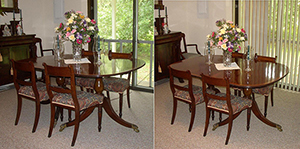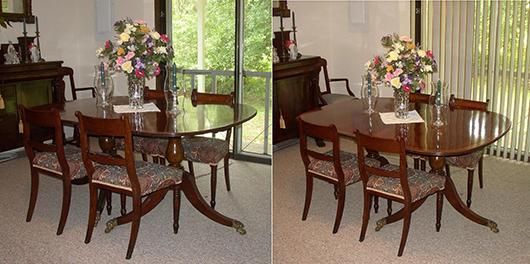
In many traditional homes, and in many of the “other” kind, which seems to include mine, there often appears to be a preoccupation with the dining room. Other parts of the house are important, but the eatery is special. The living room is usually reserved for entertaining important guests – no kids, no fun, no food and no pets allowed. But the dining room actually has a real purpose. And it also excludes most of the things forbidden in the Living Room with the exception of the part about food.
Since dedicated eating space is such a relatively new innovation in American architecture and since the idea of all matching furnishings in that space is even newer, it is interesting to note how much tradition and importance have been assigned to the space and the furniture. Even the area designated for dining in Thomas Jefferson’s masterpiece, Monticello, was not set with a permanent table. Small tables were arranged from storage along the wall to accommodate the correct number of diners for each event. After Jefferson, things got a lot more ritualized in America. In fact during the mid-Victorian period in America the Dining Room accumulated so much symbolism and mystery that the former Chair of the Office of Advanced Studies at the Winterthur Museum, Kenneth L. Ames, wrote a book in 1992 to help us make some sense of it all. The book is titled Death in the Dining Room & Other Tales of Victorian Culture, published by Temple University Press. Despite the daunting title it is an easy, entertaining and rewarding read and actually sheds light on several complicated Victorian customs, rituals and traditions. It also explains a lot about my grandparents who were born in the early 1880s.
But most of us don’t have an example of the magnificently symbolic sideboard made by A.G. Fourdinois in Paris in 1851 and exhibited in the Great Exhibition in London the same year. We don’t even have the American version, made by Bulkley & Herter, which was shown at the American Crystal Palace in New York in 1853. It’s just as well. We generally wouldn’t have neither the time to study the symbolism nor the energy to clean all the majestic little “dustable” places incorporated into the designs.
What many of us do have, however, is a room, or at least some space, reserved for those eating occasions that require a more formal atmosphere than the kitchen bar or the breakfast nook. It may not be fancy. It may not be expensive. The furniture is probably not what we would see at the White House or even at a smart private club, but it is ours and we probably spent more on it than we care to admit. So now the problem is to take care of it so we don’t have to spend that outrageous amount of money again before we are ready.
Here are some general thoughts about maintaining your dining room furniture on a regular basis. Most of it is common sense coupled with a little elbow grease mixed in with some people skills.
Other than water, the greatest enemy of your fine furniture, dining or otherwise, is strong light – primarily sunlight. We all love to see the sunbeams twinkling brilliantly across the polished surfaces in our dark caves, but learn to think of those sunbeams as laser guns or atomic blasters. While they may deliver a warm mellow glow to your skin after a day outside, they will do the opposite to the color in your antique dining table – and chairs – and sideboard – and corner cupboard. Over a period of years exposure to exterior light from a window or sliding door will seriously drain the intensity of the color of the wood in your furniture. This is especially true of harsh direct sunlight but it even includes incidental light that manages to pry its way in through a north window.
One of the most obvious things you can do is to pull the drapes on the offending window or door. Yes, it will be darker but you aren’t in that room very often for very long. When you are not there close up the room. Open it when you need the space and feel free to turn on the electric lights. That source of light, while not ideal, is not as harmful as sunlight.
Aside from light source protection one of the one simplest but most beneficial things you can do for your dining set is to rotate it. No matter how careful you are with light pollution and exposure to heating and air-conditioning vents, the components of a set of furniture eventually will start to exhibit minor differences in color, cleanliness and wear based almost exclusively on how the components are arranged in their space and how they are used. The backs of chairs exposed to a window for many years will eventually fade, while the fronts of the chairs on the opposite side of the table will too – not to mention the sides of the table if it is not covered. And if you use your set on a regular basis and the same people sit in the same place every time, sooner or later the location of the sloppy eaters becomes apparent from the condition of the table itself, the tablecloth, the chair and the carpet. Pick a single date in the year, like your birthday or the first day of spring – anything as long as you are consistent from year to year – and use that day to completely rotate the orientation of your dining room set – table, chairs, carpet, china cabinet, art work – the works. Just keep telling yourself “change is good.” The major caveat for this operation is not to attempt to move all this stuff by yourself. Sure you can move the chairs and the artwork and the plant stand but it takes at least two people to move a full-size dining table. Do the same for a china cabinet and sideboard, especially if you are moving them out of the room to rotate the area rug under the table.
One final note about light and fading: Placing objects of decoration on a tabletop for an extended period of time can often lead to undesirable consequences. In the case of the silver or mirrored tray placed in the center of the table to hold the magnificent artificial flower arrangement, even if you rotate the table and everything else in the dining room, the same spot in the center of the table is covered. Years from now when you examine the bare table in adequate light you will see the dark shadow of the sheltered spot, coincidentally shaped exactly like the tray. To a lesser extent the same holds true for wide-bodied candle stands, epergnes and pottery. Be mindful of what you place on the table and for how long you leave it there.
One of the best acquisitions you can make for your dining room table is a set of custom-made high quality table pads. You can mess around for years with rubber sheets, quilts, blankets, tablecloths, placemats and all the other low-cost substitutes, but eventually you will grow tired of the bother and disgusted with the inadequate results. When that happens call a good furniture restoration artist (you should know one anyway) and ask what brand of table pad he or she recommends and who sells them. It will be easier than you think. In most cases the company will send a local rep to your house to measure the table and show you samples of the bottom suede or velvet lining and let you pick your color of top vinyl covering. After placing the order your pads normally arrive in about two weeks. Good ones will come with latches or locks that hold individual sections of the pad together while they are in place on the tabletop. But do not leave the pads installed permanently. They should be stored in their original box in a horizontal position when not in use.
And speaking of storage – are the extra expansion leaves of your table standing up in the hall closet (bedroom closet, kitchen cabinet) awaiting their next use? The longer they lean against the wall in the closet the more likely they are to develop a bad case of “no longer straight and flat”. In other words they will warp, just like any long board or piece of plywood standing on edge against a wall. The leaves should be wrapped loosely in thin blanket and store horizontally (along with the table pads) under your bed, out of the way.
Finally you should produce a filmed inventory of most of your household belongings, but especially of your expensive and better furniture and antiques. If you can afford it have this done by a professional who probably has better equipment than you do and who can edit and label your final product. Keep this inventory in a safe deposit box along with the professional appraisals you have had done of your better stuff items.
There are lots of other things you need to be doing on regular basis for and to your furniture but those are for another time.
Send your comments, questions and pictures to Fred Taylor at P.O. Box 215, Crystal River, FL 34423 or email them to him at info@furnituredetective.com.
Visit Fred’s website at www.furnituredetective.com. His book How To Be a Furniture Detective is available for $18.95 plus $3 shipping. Send check or money order for $21.95 to Fred Taylor, P.O. Box 215, Crystal Fiver, FL, 34423.
Fred and Gail Taylor’s DVD, Identification of Older & Antique Furniture ($17 + $3 S&H) is also available at the same address. For more information call 800-387-6377, fax 352-563-2916, or info@furnituredetective.com. All items are also available directly from his website.

ADDITIONAL IMAGE OF NOTE



